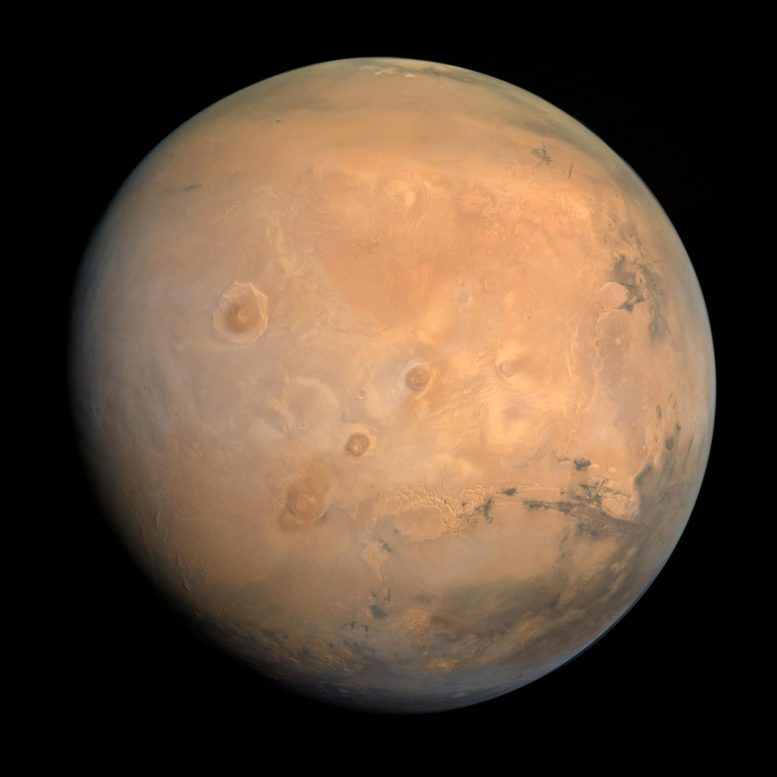
A study has revealed that ancient Mars had a low groundwater recharge rate, suggesting that although there is evidence of water on its surface, the planet's water system was very different from Earth's. This result, derived from different modeling approaches, highlights challenges in understanding Mars' hydrological past and has implications for future exploration and search for water resources. (Artist's concept.) Credit: SciTechDaily.com
Research indicates that it is ancient Mars It had minimal groundwater recharge, and differed significantly from water dynamics on Earth, affecting our understanding of its climate and aiding future Mars missions.
Mars was once a wet world. The Red Planet's geological record shows evidence of water flowing on the surface – from river deltas to valleys carved by massive floods.
But a new study shows that no matter how much rain fell on ancient Mars, little of it seeped into the aquifer in the planet's southern highlands.
A graduate student at the University of Texas at Austin made the discovery by modeling the groundwater recharge dynamics of an aquifer using a range of methods — from computer models to simple calculations.

Mars in true colours, captured by the Emirates Mars Mission in August 2021. Photograph: Kevin M. Gill
Groundwater recharge on Mars
Regardless of complexity, the results converged on the same answer – a meager 0.03 mm of groundwater recharge per year on average. This means that wherever rain fell in the model, only an average of 0.03 millimeters per year would have entered the aquifer and continued to produce the remaining landforms on the planet today.
For comparison, the annual rate of groundwater recharge for the Trinity and Edwards Trinity aquifers that supply water to San Antonio generally ranges from 2.5 to 50 millimeters per year, or about 80 to 1,600 times the Martian aquifer recharge rate calculated by the researchers.
There are a variety of possible reasons for such low rates of groundwater flow, said lead author Eric Hiatt, a doctoral student at the Jackson School of Geosciences. When it rained, the water may have mostly washed across the Martian landscape as runoff. Or maybe it didn't rain much at all.
Implications for the climate and exploration of Mars
These results could help scientists constrain the climate conditions capable of producing rain on early Mars. They also indicate a completely different water system on the Red Planet than exists on Earth today.
“The fact that groundwater isn't a big deal might mean other things are as well,” Hiatt said. “This might exaggerate the importance of runoff, or it might mean it didn't rain as much on Mars. But it's fundamentally different from the way we think about it.” [water] On the ground.”
The results were published in the journal Icarus. Co-authors of this paper are Muhammad Afzal Shadab, a doctoral student at the Jackson School, and faculty members Sean Gulick, Timothy Goode, and Mark Hess.

Lead author Eric Hiatt, a doctoral student in the UT Austin Jackson School of Geosciences, with a Mars globe. Credit: University of Texas at Austin/Jackson School of Geosciences
The models used in the study work by simulating groundwater flow in a “steady-state” environment where water inflow into the aquifer and outflow are balanced. Next, the scientists varied the factors influencing the flow — for example, where precipitation fell or the average porosity of the rocks — and observed what other variables would have to change to maintain the steady state and how plausible those charges were.
While other researchers have simulated groundwater flow on Mars using similar techniques, this model is the first to incorporate the influence of oceans that existed on Mars more than three billion years ago in the Hellas, Argyri, and Borealis basins.
The study also includes recent topographic data collected by satellite. Hiatt said modern landscapes still retain one of the oldest and most influential topographic features on the planet — the extreme difference in elevation between the northern hemisphere – the lowlands – and the southern hemisphere – the highlands – known as the Great Divide. This division retains signs of past groundwater uplift, as groundwater rose from the aquifer to the surface. Researchers have used geological markers of past upwelling events to evaluate the outputs of various models.
Through various models, the researchers found an average groundwater recharge rate of 0.03 millimeters per year, which closely matches what is known from the geological record.
The search is not just limited to understanding the Red Planet's past. It has implications for future Mars exploration as well. Understanding groundwater flow can help determine where to find water today, Hiatt said. Whether you're searching for signs of ancient life, trying to support human explorers, or making rocket fuel to return to Earth, it's essential to know where water is most likely to be.
Reference: “Limited recharge of the Southern Highlands Aquifer on Early Mars” by Eric Hiatt, Muhammad Afzal Shadab, Sean P. S. Gulick, Timothy A. Jude and Mark A. Hesse, September 9, 2023, Icarus.
doi: 10.1016/j.icarus.2023.115774
The research was funded by NASAand the University of Texas Geophysics Institute and the UT Center for Planetary Habitation.

“Web maven. Infuriatingly humble beer geek. Bacon fanatic. Typical creator. Music expert.”





More Stories
NASA Close to Deciding What to Do With Boeing’s Troubled Starliner Spacecraft
Scientists May Have Discovered ‘Dark Oxygen’ Created Without Photosynthesis: NPR
Real Scientists Lived on Fake Mars in a Texas Shed for a Year